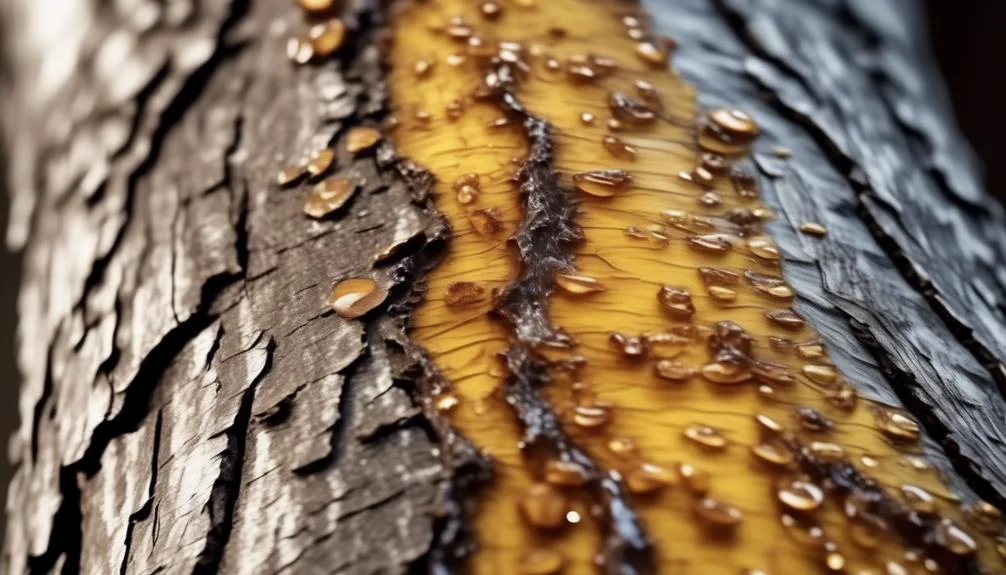Elm tree resin, a sticky and aromatic substance used for centuries, holds potential benefits worth exploring.
While maple syrup and bee propolis are well-known, elm tree resin's properties, practical uses, and potential health benefits remain less acknowledged.
Could this natural substance be useful in modern times?
Let's delve into its properties and practical uses to uncover its potential in today's world.
Properties of Elm Tree Resin
Elm tree resin is a natural, sticky substance that's exuded from the bark of elm trees and has been used for centuries for its healing and protective properties. Its chemical composition varies based on the species of elm tree, but generally includes compounds like terpenes, phenolics, and flavonoids. These components contribute to the resin's antimicrobial, anti-inflammatory, and antioxidant properties, making it a valuable natural remedy for various ailments.
In industrial applications, elm tree resin is used in the manufacturing of adhesives, varnishes, and coatings due to its excellent adhesive and protective qualities. Its ability to form strong bonds with different materials makes it a sought-after ingredient in the production of wood glues and sealants. Additionally, the resin's natural waterproofing properties make it a valuable component in the formulation of protective coatings for various surfaces.
Practical Uses of Elm Tree Resin
With its diverse array of practical applications, elm tree resin's versatility extends beyond its traditional healing and protective properties, finding utility in various industrial and commercial uses. Elm tree resin is prized for its practicality in a wide range of applications, offering a valuable resource for crafting projects and natural remedies.
Here are five practical uses of elm tree resin:
- Crafting projects: Elm tree resin is often used as a natural adhesive in woodworking and crafting, providing a strong and durable bond for various projects.
- Natural remedies: The resin is known for its medicinal properties and is used in traditional medicines for its healing and soothing effects on skin irritations and minor wounds.
- Industrial sealant: Elm tree resin serves as an effective sealant for industrial applications, providing a waterproof and protective barrier in various products.
- Aromatherapy: The aromatic properties of elm tree resin make it a popular choice for use in aromatherapy and fragrance products.
- Wood preservation: Elm tree resin is used to protect and preserve wood, extending its lifespan and maintaining its natural beauty.
Health Benefits of Elm Tree Resin
Boasting an array of potential health benefits, elm tree resin has been revered for its healing properties in various traditional remedies.
Traditionally, it has been used to treat sore throats, coughs, and skin irritations due to its soothing and anti-inflammatory properties. Elm tree resin is known for its ability to form a protective coating over irritated tissues, offering relief and promoting healing.
In modern applications, it's often included in natural cough syrups, lozenges, and topical ointments for its therapeutic effects. The resin's antimicrobial properties also make it a valuable ingredient in natural wound healing products.
Additionally, its use in natural remedies for digestive issues and oral health concerns is gaining attention for its potential to support overall wellness.
How to Harvest Elm Tree Resin
After learning about the potential health benefits of elm tree resin, you may be curious about how to harvest this valuable natural substance. Here are some steps to guide you through the resin collection process:
- Identify Suitable Elm Trees: Look for mature elm trees with rough bark, as they're more likely to produce resin.
- Choose the Right Time: The best time to harvest elm tree resin is during the early spring when sap is flowing.
- Prepare the Tree: Clean the bark surface where you plan to tap the tree to ensure a clean collection area.
- Tree Tapping: Use a sharp knife to make a small, shallow incision in the bark to release the resin.
- Collect the Resin: Place a container below the incision to catch the dripping resin.
Safety Precautions When Using Elm Tree Resin
To ensure safe and effective use of elm tree resin, it is important to be mindful of certain safety precautions. When handling elm tree resin, it is crucial to protect yourself from potential skin irritation and allergic reactions. It's also important to consider respiratory protection and proper handling techniques. Below is a table summarizing the safety precautions when using elm tree resin:
| Safety Precautions | Description |
|---|---|
| Respiratory Protection | Use a mask or respirator to avoid inhaling resin fumes. |
| Handling Techniques | Wear gloves and use tools to minimize skin contact. |
| Skin Irritation | Wash skin thoroughly after handling resin to prevent irritation. |
| Allergic Reactions | Be aware of any allergic reactions and seek medical help if necessary. |
Conclusion
Incorporating elm tree resin into your natural remedies or practical applications can bring antibacterial, anti-inflammatory, adhesive, and waterproof benefits.
Harvest and use it responsibly to experience its valuable properties and potential for various uses.
How might elm tree resin enhance your daily life?

My interest in trees started when I first saw the giant sequoias in Yosemite.
I was a teenager then, and I remember thinking, “I need to learn more about this.”
That moment stuck with me.
A few years later, I went on to study forestry at Michigan Tech.
Since graduating, I’ve worked in a mix of hands-on tree care and community education.
I’ve spent over ten years helping people understand how to plant, maintain, and protect the trees in their neighborhoods.
I don’t see trees as just part of the landscape.
They are living things that make a real difference in our daily lives.
